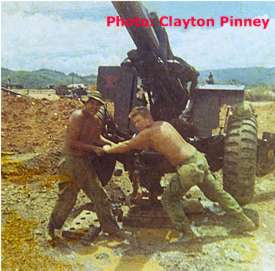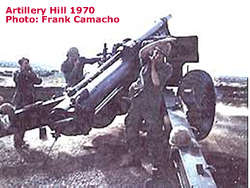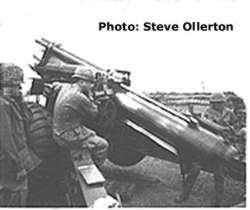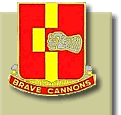|
Registration:
after a move to make sure you and everyone around you were on the same
page and make sure nothing was damaged in transit. Also known as marking
rounds.
 Defensive
Target (DT's) zeroing for the friendly forces within your range
protection. DT's could be fired day or night and often when Long Range
Reconnaissance Patrols (LRRP's) and Special Forces were within range
we would plot DT''s around them, and shoot them on call. At night, your
location was generally set until morning and you did not want to move
without telling Artillery... otherwise, you were dead meat. Defensive
Target (DT's) zeroing for the friendly forces within your range
protection. DT's could be fired day or night and often when Long Range
Reconnaissance Patrols (LRRP's) and Special Forces were within range
we would plot DT''s around them, and shoot them on call. At night, your
location was generally set until morning and you did not want to move
without telling Artillery... otherwise, you were dead meat.
Harassment
and Interdiction (H&I's) missions fired on suspect and known areas
where the enemy was known to hide, set up ambushes, set up rockets,
infiltration and escape routes. Used to keep them from getting too comfortable.
This was the job of "Hot Gun" in our unit.
Contact
fire missions were used when any friendly came in contact with the enemy
and needed support.
Time
on Target (TOT) missions were used to surprise and devastate an
area almost instantaneously. Used if an area was suspect of being a
VC/NVA hotspot, or if an LZ needed to be prepped prior to inserting
assault forces. A typical TOT might involve 4 or more batteries of different
calibers. With rounds fused for point detonation (fuse Quick) as well
as fused for airburst (fuse VT) the Arty units could deliver over 1
ton of High Explosive (HE) to one point at one time. You do not want
to be here.
Illumination ("Illum") missions were typically employed
when the enemy was too close to the friendly forces to successfully
support them with HE or when they wanted to check an area close to their
perimeter when a guard hears a noise or a trip flare goes off.
Killer
Junior missions were developed out of the need to protect ones self
from ground attacks and since the Artillery Gods didn't design a "Beehive"
round for the 155 mm Howitzer. Killer Juniors were perfected by Lt.
Colonel Robert Dean the CO of 1/8th Field Artillery, 25th Infantry Division
Artillery. The technique called for firing HE Projectiles with Time
Fuses set at 2 seconds or greater to burst approximately 30 feet off
the ground at ranges of 200 to 1,000 meters. Killer Juniors (and the
8" Killer Senior) proved to be more effective than Beehive for
antipersonnel because the enemy could not crawl under the burst as they
could the fan of the Beehive pattern.
 Radioed
in by a Forward Observer (FO) traveling with ground troops. The ground
troops may have observed from a distance or be "In Contact"
with the enemy at the time of the mission. Radioed in by a Forward Air
Controller (FAC) from a spotter plane (AO-1 Bird-dog) or from a helicopter
on a recon or support mission. Fire missions were obtained by FDC from
a variety of sources, some of which included: As explained earlier,
H&I's were fired on predetermined targets, the data for which were maintained
in FDC. Radioed
in by a Forward Observer (FO) traveling with ground troops. The ground
troops may have observed from a distance or be "In Contact"
with the enemy at the time of the mission. Radioed in by a Forward Air
Controller (FAC) from a spotter plane (AO-1 Bird-dog) or from a helicopter
on a recon or support mission. Fire missions were obtained by FDC from
a variety of sources, some of which included: As explained earlier,
H&I's were fired on predetermined targets, the data for which were maintained
in FDC.
With the exception of Killer Junior missions, all fire missions were
phoned into the gun crews from the Fire Direction Center (FDC). FDC
would tell the gun crews the Azimuth, Projectile type, Fuse, Fuse setting
(where applicable), Powder Charge (green bag or white bag), the Quadrant
and Deflection settings. When the Pig was laid, the gun would generally
fire one round and adjust if needed before they would fire additional
rounds. Typically, the howitzer closest to the Battery Center also called
the Base Piece fired the first round. After the proper range and other
data were corrected from the Base Piece, the Battery might fire one
round or multiple rounds depending on what the Forward Observer has
requested. Called in by another Firebase within range that may be under
attack. The data for these firebases was also maintained in FDC. |



 Defensive
Target (DT's) zeroing for the friendly forces within your range
protection. DT's could be fired day or night and often when Long Range
Reconnaissance Patrols (LRRP's) and Special Forces were within range
we would plot DT''s around them, and shoot them on call. At night, your
location was generally set until morning and you did not want to move
without telling Artillery... otherwise, you were dead meat.
Defensive
Target (DT's) zeroing for the friendly forces within your range
protection. DT's could be fired day or night and often when Long Range
Reconnaissance Patrols (LRRP's) and Special Forces were within range
we would plot DT''s around them, and shoot them on call. At night, your
location was generally set until morning and you did not want to move
without telling Artillery... otherwise, you were dead meat. Radioed
in by a Forward Observer (FO) traveling with ground troops. The ground
troops may have observed from a distance or be "In Contact"
with the enemy at the time of the mission. Radioed in by a Forward Air
Controller (FAC) from a spotter plane (AO-1 Bird-dog) or from a helicopter
on a recon or support mission. Fire missions were obtained by FDC from
a variety of sources, some of which included: As explained earlier,
H&I's were fired on predetermined targets, the data for which were maintained
in FDC.
Radioed
in by a Forward Observer (FO) traveling with ground troops. The ground
troops may have observed from a distance or be "In Contact"
with the enemy at the time of the mission. Radioed in by a Forward Air
Controller (FAC) from a spotter plane (AO-1 Bird-dog) or from a helicopter
on a recon or support mission. Fire missions were obtained by FDC from
a variety of sources, some of which included: As explained earlier,
H&I's were fired on predetermined targets, the data for which were maintained
in FDC.